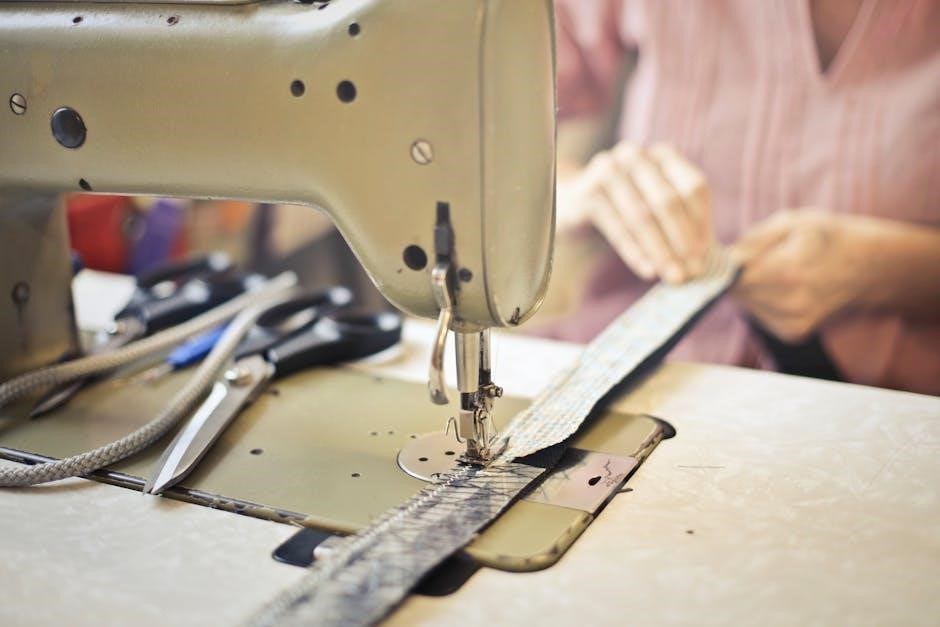
Welcome to the Kenmore Sewing Machine Model 158 Manual, your essential guide to mastering this versatile sewing machine. This manual provides comprehensive instructions, safety tips, and troubleshooting solutions to ensure optimal performance. Designed for both beginners and experienced sewers, it covers everything from basic setup to advanced techniques. Follow this guide to unlock the full potential of your Kenmore Model 158 and enjoy seamless sewing experiences.
Importance of the Manual
The Kenmore Sewing Machine Model 158 Manual is a comprehensive guide essential for mastering your sewing machine. It provides detailed instructions for safe operation, troubleshooting, and maintenance, ensuring optimal performance. Whether you’re a beginner or an experienced sewer, this manual offers clear explanations of features, stitch selection, and advanced techniques. By following the manual, you can avoid common mistakes, extend the machine’s lifespan, and achieve professional-quality results. It serves as your go-to resource for understanding and maximizing the potential of your Kenmore Model 158, making it indispensable for any sewing project.
Key Features of the Kenmore Sewing Machine Model 158
The Kenmore Model 158 sewing machine offers versatile stitching options, including straight stitch, zigzag, and decorative stitches. It features an automatic threading system and adjustable tension control for consistent stitching. The machine is designed with a durable metal frame for long-lasting performance. It includes multiple presser feet for various sewing tasks, such as buttonholes and zippers. The easy-to-use interface and portable design make it suitable for both beginners and experienced sewers. This machine is compatible with a wide range of fabrics, ensuring versatility for any project. The Kenmore Model 158 manual provides detailed guidance on utilizing these features effectively and accessories.
Target Audience for the Manual
This manual is designed for hobbyists, DIY enthusiasts, and home sewers seeking to master the Kenmore Model 158. It is ideal for beginners learning the basics of sewing and for experienced users looking to optimize their machine’s performance. The guide also caters to educators teaching sewing classes and professionals needing reliable equipment for small-scale projects. Anyone interested in understanding the Kenmore Model 158’s operation, maintenance, and troubleshooting will find this manual invaluable. It ensures that users of all skill levels can utilize the machine effectively and safely, making it a comprehensive resource for sewing enthusiasts everywhere.
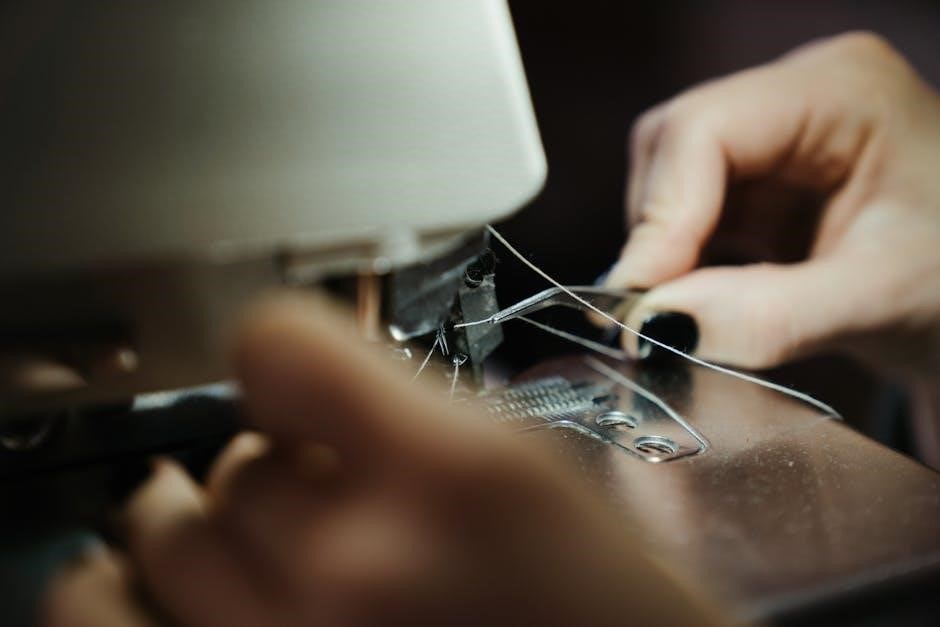
Safety Precautions and Best Practices
Always unplug the machine when not in use and keep loose clothing tied back. Avoid sewing flammable or unsafe materials. Follow guidelines to prevent accidents.
General Safety Guidelines
Always unplug the Kenmore Sewing Machine Model 158 when not in use to prevent accidents. Keep loose clothing and long hair tied back to avoid entanglement. Ensure children and pets stay away while operating. Use only recommended needles and accessories to maintain safety. Never sew over pins, and handle sharp objects with care. Regularly clean and maintain the machine to ensure proper function. Following these guidelines will help prevent injuries and prolong the machine’s lifespan.
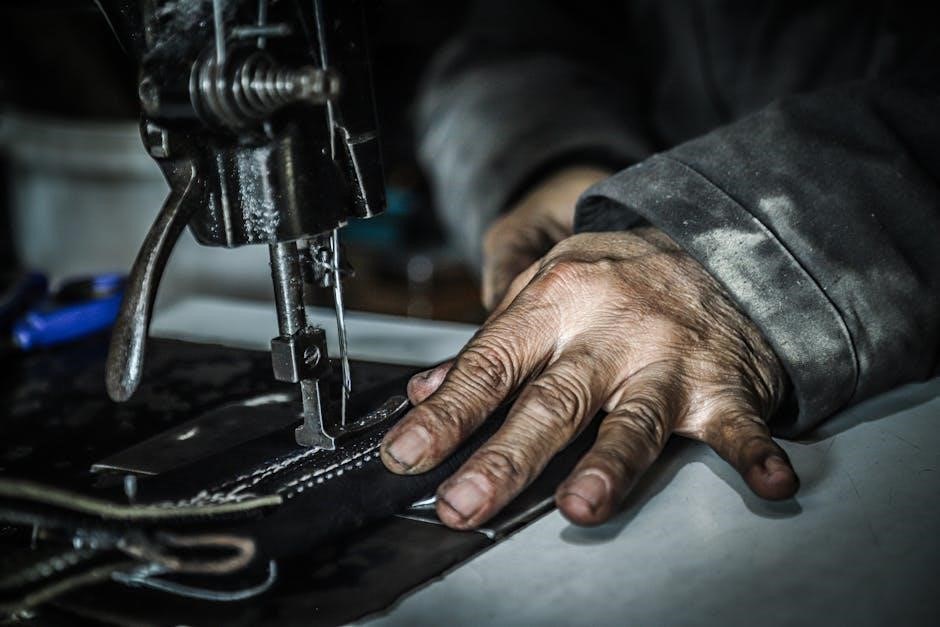
Specific Safety Tips for the Kenmore Model 158
For the Kenmore Model 158, always unplug the machine before cleaning or oiling. Use only genuine Kenmore needles to avoid damage. Keep fingers away from the needle area while sewing. Regularly check for thread or lint buildup in the bobbin area. Avoid sewing over pins, as this can damage the machine. Never use flammable liquids near the machine. Store the machine in a dry, cool place when not in use. Follow the manual’s oiling instructions to ensure smooth operation. Proper maintenance will enhance safety and performance.

Getting Started with the Kenmore Sewing Machine Model 158
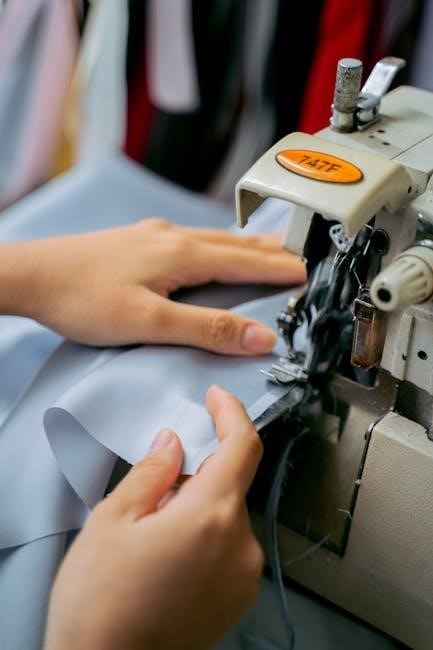
Welcome to the Kenmore Model 158! Start by carefully unboxing and inspecting your machine. Familiarize yourself with its components and features. Set up your workspace neatly, ensuring good lighting and accessibility. Refer to the manual for initial setup guidance and begin exploring your machine’s capabilities.
Unboxing and Initial Setup
Excited to start with your Kenmore Sewing Machine Model 158? Begin by carefully unboxing and inspecting all components. Ensure the machine, accessories, and manual are included. Gently remove packaging materials and place the machine on a stable, flat surface. Before powering up, clean any protective covering and inspect for damage. Locate the manual for specific setup instructions. Organize your workspace with essential tools like scissors, threads, and fabric. Familiarize yourself with the machine’s parts and features. Proper unboxing and setup ensure a smooth sewing experience from the start.
Identifying Machine Parts and Components
Familiarizing yourself with the Kenmore Sewing Machine Model 158 is crucial for effective operation. Locate the spool pins, tension dials, and stitch selectors on the top. The bobbin compartment and feed dogs are accessible below. Identify the power switch, foot pedal, and thread cutters for ease of use. Check the accessory compartment for included attachments. Understanding each part ensures proper setup and operation. For new users, consult the manual diagrams to match names with functions. This knowledge enhances your sewing experience and simplifies troubleshooting. Take time to explore and label each component for future reference.
Setting Up Your Workspace
Setting up your workspace is essential for a comfortable and efficient sewing experience. Place the Kenmore Sewing Machine Model 158 on a stable, flat surface, ensuring good lighting. Keep the area clean and clutter-free to prevent accidents. Organize your fabrics, threads, and notions within easy reach. A well-organized workspace enhances productivity and reduces stress.
Additionally, consider using a sewing mat or extension table for larger projects. Store accessories like bobbins and needles in a designated container. Ensure the machine is at a comfortable height to avoid strain. A tidy and ergonomic workspace promotes creativity and accuracy while sewing.

Threading the Kenmore Sewing Machine Model 158
Proper threading is essential for smooth operation. Follow the step-by-step guide in the manual to thread the machine correctly, avoiding common mistakes. Ensure tension is balanced and_threads are securely placed. Regularly check for tangles or lint buildup. For optimal performance, use high-quality threads and refer to the manual for specific threading instructions tailored to the Kenmore Model 158.
Step-by-Step Threading Process
Turn off the machine and locate the spool pin. Place the thread on the pin, leaving a small tail. 2. Guide the thread through the tension disc and take-up lever, ensuring it seats properly. 3. Insert the thread into the needle bar groove, then thread the needle from front to back. 4. For the bobbin, wind the thread clockwise around the bobbin winder. 5. Re-thread the machine with the bobbin in place. 6. Gently pull the thread to ensure it’s taut and properly seated. Follow these steps carefully to avoid tangles and ensure smooth stitching.
Common Threading Mistakes to Avoid
Avoid common threading mistakes to ensure smooth operation. 1. Never skip the take-up lever, as this disrupts tension. 2. Don’t pull thread too tightly, as it can misalign the needle bar. 3. Ensure the bobbin is properly seated and threaded through the bobbin case. 4. Avoid crossing threads or twisting them, which can cause tangles. 5. Don’t overlook the tension discs; thread must pass through correctly. 6. Never thread with the presser foot down, as it engages the feed dogs. Correct threading ensures proper stitch formation and prevents machine damage. Always refer to the manual for guidance.
Advanced Threading Tips for Optimal Performance
For optimal performance, use high-quality thread suitable for your fabric type. Always pre-cut threads to avoid tangles and ensure smooth flow. Gently tug the thread after each step to eliminate slack; Use the built-in thread cutter for clean ends, preventing loose strands. Apply a slight twist to the thread before inserting it into the needle to reduce fraying. Regularly clean the tension discs and bobbin area to maintain consistent thread flow. Experiment with thread weights for different fabrics, and consider using a thread conditioner for silk or delicate materials. Proper threading techniques enhance stitch quality and prolong machine longevity.

Basic Operations and Stitch Selection
The Kenmore Model 158 offers a variety of stitch options, including straight, zigzag, and decorative stitches. Adjust stitch length and width for different fabrics, ensuring precise results. Always match stitch type to fabric thickness for professional finishes. Use the dial or button controls to effortlessly switch between stitches. Begin with a test stitch on scrap fabric to confirm settings before sewing. This feature-rich machine is designed to simplify your sewing experience, catering to both beginners and advanced users with its intuitive stitch selection system.
Understanding Stitch Types and Selection
The Kenmore Sewing Machine Model 158 offers a variety of stitch types to suit different sewing needs. These include straight stitches, zigzag stitches, and decorative stitches. Straight stitches are ideal for basic sewing tasks like joining fabrics, while zigzag stitches are perfect for preventing fraying on raw edges. Decorative stitches add aesthetic value to your projects. The machine allows easy stitch selection using a dial or button controls. Always choose the appropriate stitch type based on fabric thickness and project requirements. For example, use a tighter stitch for heavy fabrics and a looser stitch for delicate materials. This ensures professional-looking results every time.
Adjusting Tension for Different Fabrics
Proper tension adjustment is crucial for achieving even stitches on the Kenmore Sewing Machine Model 158. For lightweight fabrics like cotton or silk, a lighter tension setting is recommended to prevent puckering. Heavier fabrics, such as denim or polyester, require a tighter tension to ensure strong, consistent stitches. Use the tension dial on the machine to make adjustments, testing on scrap fabric before sewing your final project. Incorrect tension can lead to loose threads or uneven stitching. Always refer to the machine’s guidelines for specific fabric recommendations and adjust accordingly for optimal results. This ensures professional-quality outcomes for every sewing task.
Basic Sewing Techniques for Beginners
Mastering basic sewing techniques with the Kenmore Sewing Machine Model 158 is simple and rewarding. Start with straight-line stitching, ensuring fabric is aligned and guided smoothly under the needle. Use the backstitch feature at the beginning and end of seams for durability. Practice turning fabric correctly to maintain direction and alignment. Keep the fabric moving steadily to avoid bunching or dragging. For beginners, start with cotton fabrics and gradually experiment with different materials. Always use the appropriate foot for the type of stitching to maintain even tension and control. These foundational techniques will help you build confidence and achieve professional-looking results.
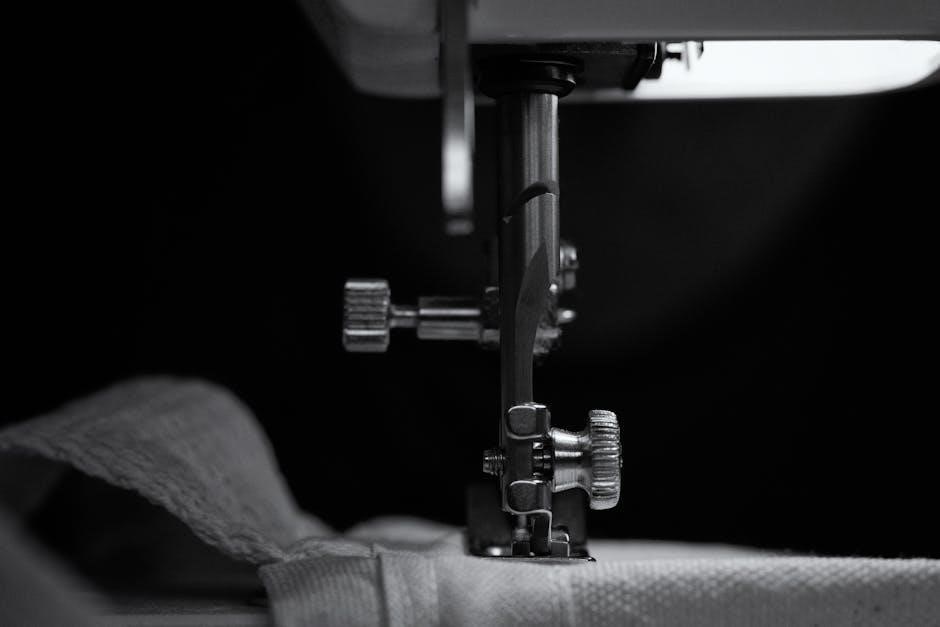
Maintenance and Care for the Kenmore Model 158
Regular cleaning, oiling, and proper storage are essential to maintain the Kenmore Model 158’s performance. Clean lint and debris after use, oil moving parts, and store in a dry, cool place to extend its lifespan and ensure smooth operation.
Cleaning the Machine Regularly
Regular cleaning is crucial for the Kenmore Model 158’s performance. Remove the top cover and thoroughly inspect for thread or lint buildup. Use a soft brush or small vacuum to clean debris from the machine’s interior. Pay attention to areas around the bobbin and tension discs. Avoid using harsh chemicals or abrasive materials, as they may damage the finish. For stubborn lint, dampen a cloth with water, but ensure the machine is dry before use. Regular cleaning prevents jams, ensures smooth stitching, and extends the machine’s lifespan. Make this a routine part of your sewing practice for optimal results.
Oiling and Lubrication Tips
Regular oiling is essential to maintain the Kenmore Model 158’s smooth operation. Use high-quality sewing machine oil, applying a few drops to the metal parts, such as the bobbin area and tension discs. Oil every 1-2 months or after 10 hours of use. Avoid over-oiling, as it can attract dust and cause issues. Gently turn the handwheel to distribute the oil evenly. For best results, use the oil recommended in the manual. Proper lubrication reduces friction, prevents wear, and ensures consistent stitching. Keep your machine well-oiled to prolong its lifespan and maintain peak performance.
Storage and Transportation Best Practices
Proper storage and transportation are crucial to maintaining your Kenmore Model 158’s condition. Always clean the machine before storing it in a dry, cool place, away from direct sunlight. Use a dust cover to protect it from debris. For transportation, secure the machine in its original case or a sturdy box with padding. Avoid exposing it to extreme temperatures or moisture. Handle the machine with care to prevent damage to internal components. Regularly inspect for dust or damage before use. By following these practices, you can ensure your Kenmore Model 158 remains in excellent working condition for years to come.
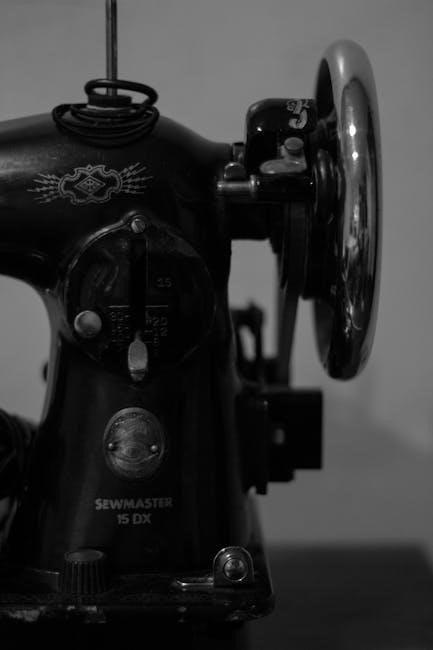
Troubleshooting Common Issues
- Identify thread breakage, tension imbalances, and noise problems.
- Regular maintenance and proper threading prevent these issues effectively.
Identifying and Solving Thread Breakage
Thread breakage on the Kenmore Sewing Machine Model 158 often occurs due to improper threading, tension imbalances, or debris in the machine. To resolve this, first, turn off the machine and carefully remove any broken thread. Check for lint or dust in the tension discs, take-up lever, and bobbin area. Clean these parts thoroughly with a soft brush. Re-thread the machine following the manual’s step-by-step guide, ensuring the presser foot is up. If issues persist, adjust the tension settings or replace the needle. Regular maintenance and using high-quality thread can prevent future breakage.
Fixing Tension Imbalances
Tension imbalances on the Kenmore Sewing Machine Model 158 can cause uneven stitches or fabric pulling. To fix this, start by checking the thread path for proper seating in the tension discs. Ensure the presser foot is raised when re-threading to activate the tension mechanism. Adjust the upper and bobbin tension dials in small increments, testing stitches after each change. Clean the tension discs with a soft brush to remove lint or debris. If issues persist, consult the manual for specific tension settings for your fabric type. Proper tension balance ensures smooth stitching and optimal sewing performance.
Addressing Noise or Vibration Problems
Noise or vibration issues with the Kenmore Sewing Machine Model 158 can disrupt your sewing experience. Check for improper threading, as this often causes unusual sounds. Ensure all parts are securely tightened and free from lint or debris. If the machine vibrates excessively, verify that it’s placed on a stable, flat surface. Lubricate moving parts regularly to reduce friction and noise. Consult the manual for specific maintenance tips, and consider professional servicing if problems persist. Proper care and regular cleaning can help maintain smooth, quiet operation.
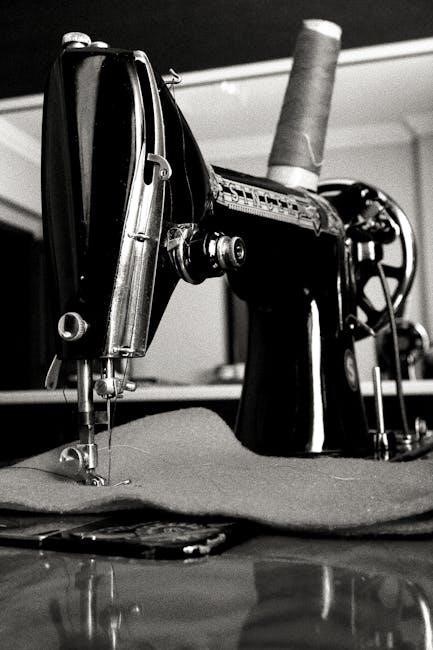
Accessories and Attachments for the Kenmore Model 158
The Kenmore Model 158 offers a variety of accessories, including zipper feet, buttonhole attachments, and embroidery hoops, to enhance your sewing capabilities and versatility.
Overview of Available Accessories
The Kenmore Model 158 sewing machine supports a range of accessories to expand its functionality. These include zipper feet for precise zipper installation, buttonhole attachments for custom buttons, and embroidery hoops for decorative stitching. Additional accessories like quilting extensions, walking feet, and specialized presser feet are also available. Many of these are designed to work seamlessly with the Model 158, ensuring compatibility and optimal performance. Genuine Kenmore accessories can be found through Sears Parts Direct or authorized dealers, offering high-quality solutions to enhance your sewing experience. These tools help you achieve professional results and explore creative possibilities with your machine.
Using Optional Attachments Effectively
Optional attachments for the Kenmore Model 158 can elevate your sewing projects. Use the zipper foot for smooth zipper installations and the buttonhole attachment for precise, custom buttonholes. The embroidery hoop is ideal for decorative stitching, while quilting extensions and walking feet help manage thick fabrics. Always refer to the manual for installation guidance and compatibility. Experiment with different attachments to explore new techniques and enhance your sewing skills. Proper use of these tools ensures professional results and expands your creative possibilities with the Kenmore Model 158. Start with simple projects to get familiar with each attachment before tackling more complex tasks.
Where to Find Genuine Kenmore Accessories
Genuine Kenmore sewing machine accessories can be found through Sears Parts Direct, the official Kenmore website, or authorized dealers. Visit Sears Parts Direct for a wide range of parts and diagrams specific to your Model 158. The Kenmore website also offers a dedicated section for accessories. For local options, check with authorized Kenmore dealers or sewing supply stores. Ensure authenticity by purchasing from reputable sources to maintain your machine’s performance and warranty. Avoid third-party sellers unless verified for authenticity. Always refer to your manual for compatible accessory codes to ensure the right fit for your Kenmore Model 158.
Regular maintenance, proper threading, and using genuine accessories ensure optimal performance. Troubleshoot issues promptly and explore resources for further learning. Happy sewing with your Kenmore Model 158!
Final Check List for Optimal Machine Performance
- Regularly clean the machine to remove dust and lint.
- Check and adjust thread tension before sewing.
- Lubricate moving parts as recommended.
- Use the correct needle type for your fabric.
- Ensure the workspace is well-lit and organized.
- Refer to the manual for specific fabric settings.
- Store the machine in a dry, cool place when not in use.
- Inspect for loose parts or damage before operation.
Following these steps ensures your Kenmore Model 158 performs at its best, delivering professional results for all your sewing projects.
Resources for Further Learning and Support
For additional guidance, visit Sears Parts Direct for downloadable PDF manuals and part diagrams. Explore the Kenmore website for official tutorials and FAQs. Join online sewing communities and forums for tips and troubleshooting. Watch YouTube tutorials demonstrating Model 158 techniques. Refer to the Kenmore Sewing Machine Manual 158 for detailed instructions. Access vintage sewing machine resources for nostalgic projects. Ensure you use genuine Kenmore parts for optimal performance. Visit this link for a sample manual download. These resources will enhance your sewing experience and keep your machine in top condition.